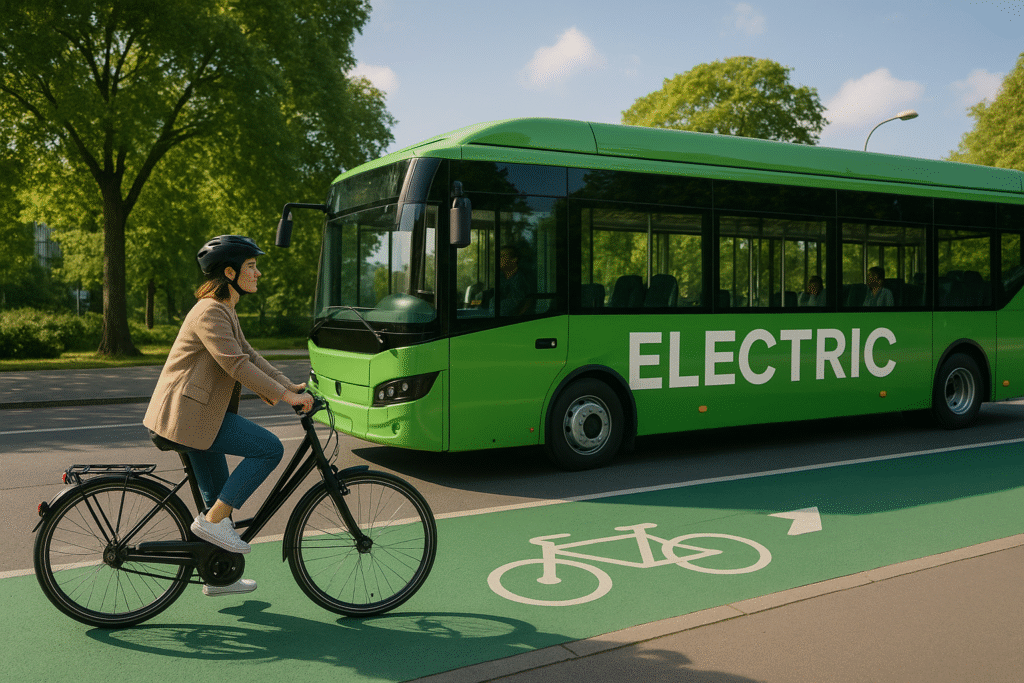Intro:
We are a team of students from Poland exploring Greece students, how artifical intelligence is transforming our future professions. During our international project, we combine technology, creativity and critical thinking to undestand AI and its impact on industry and society. Follow our journey through posts written by young mechatronics, IT and graphic design students.
Sustainable Development and AI:
Can Technology Help Us Save the Planet?

AI in Climate Change Mitigation
Artificial intelligence (AI) has rapidly emerged as a transformative tool in the global effort to combat climate change. Its capacity to analyze vast data sets, predict outcomes, optimize systems, and support decision-making has positioned AI as a crucial technology for climate action. AI applications in climate change mitigation span across diverse sectors, from improving energy efficiency and managing waste to optimizing transportation systems. However, while AI holds immense potential to drive green innovation, it also raises important questions regarding its own environmental footprint and alignment with green thinking principles.
AI in Waste Management
Effective waste management is essential in reducing greenhouse gas emissions and conserving resources. AI technologies are revolutionizing this sector by improving waste sorting, predicting waste generation, and optimizing collection routes.
AI-powered image recognition systems can accurately classify waste materials, distinguishing between recyclables, compostables, and landfill-bound items. This improves the quality of recycling streams and reduces contamination. Automated sorting facilities equipped with robotic arms and AI vision systems can process waste faster and more accurately than human workers, enhancing overall efficiency.
Predictive analytics helps municipalities and businesses anticipate waste generation patterns based on factors such as population growth, economic activity, and seasonal variations. This information informs waste reduction strategies and infrastructure planning.
Route optimization algorithms use AI to design efficient waste collection schedules and paths, minimizing fuel consumption and emissions from waste collection vehicles. These systems can adapt in real time to traffic conditions, weather events, and collection volumes, ensuring timely and eco-friendly waste management services.
AI also supports the circular economy by identifying opportunities for material recovery and reuse. Machine learning models can assess the condition of discarded items and determine their potential for refurbishment or recycling, extending product lifecycles and reducing the need for virgin materials.




Optimizing Transport Systems with AI
Transportation is a significant contributor to global greenhouse gas emissions, and AI is playing an increasingly vital role in making mobility systems more sustainable. From traffic management and public transit optimization to the development of autonomous electric vehicles, AI-driven innovations are transforming the transportation landscape.
AI algorithms optimize traffic flows by analyzing real-time data from sensors, cameras, and GPS devices. Adaptive traffic signal control systems adjust light timings based on current conditions, reducing congestion, idling time, and associated emissions. Predictive models forecast traffic patterns, enabling city planners to design infrastructure improvements and congestion mitigation strategies.
Public transportation systems benefit from AI through route optimization, demand forecasting, and dynamic scheduling. AI analyzes ridership data and external factors such as weather and events to adjust service frequency and coverage, improving efficiency and user satisfaction. AI-powered mobility-as-a-service platforms integrate various transportation modes—buses, trains, bike-sharing, and ride-hailing—into cohesive, eco-friendly networks.




The development of autonomous electric vehicles (EVs) represents a promising intersection of AI and sustainable transport. AI technologies enable self-driving cars to navigate complex environments, reducing the need for human drivers and potentially lowering accident rates. When combined with electric propulsion and shared mobility models, autonomous vehicles could significantly reduce urban emissions and improve air quality.




Evaluating AI’s Alignment with Green Thinking Principles
While AI offers substantial opportunities for advancing environmental sustainability, it is essential to critically assess its compatibility with green thinking principles. The development, deployment, and operation of AI systems involve significant energy consumption and resource use, raising concerns about their environmental footprint.
Training large AI models, particularly in fields like natural language processing and computer vision, requires vast computational resources and data centers powered by substantial amounts of electricity. The carbon emissions associated with AI training processes can be considerable, especially if the energy sources are not renewable.
Moreover, the hardware infrastructure supporting AI—including servers, storage devices, and networking equipment—consumes energy and relies on the extraction of raw materials, some of which are environmentally and socially problematic. The production and disposal of electronic components contribute to e-waste challenges and resource depletion.
To align AI development with green thinking, several strategies are being explored:
-
Energy-Efficient AI Models: Researchers are developing algorithms and architectures that require less computational power without sacrificing performance. Techniques such as model pruning, quantization, and knowledge distillation reduce energy consumption during training and inference.
-
Sustainable Data Centers: Tech companies are investing in renewable energy-powered data centers and improving cooling systems to enhance energy efficiency. Innovations in data center design, such as liquid cooling and AI-driven energy management, further reduce environmental impacts.
-
Lifecycle Assessments: Conducting comprehensive environmental impact assessments of AI systems from development through disposal helps identify areas for improvement and informs sustainable practices.
-
Ethical and Responsible AI Frameworks: Integrating environmental sustainability considerations into AI ethics guidelines ensures that ecological impacts are factored into decision-making processes.
-
Circular Economy Practices: Designing AI hardware for durability, repairability, and recyclability reduces e-waste and conserves resources. Initiatives promoting hardware reuse and responsible disposal are essential for minimizing the environmental footprint of AI infrastructure.
-
Green AI Advocacy: The AI research community increasingly advocates for „Green AI,” emphasizing the importance of energy-efficient models and transparent reporting of environmental impacts alongside performance metrics.
In conclusion, while AI presents powerful tools for addressing climate challenges, its own environmental impacts must be managed carefully. A balanced approach that maximizes AI’s benefits for climate action while minimizing its ecological footprint is essential for ensuring alignment with green thinking principles.


